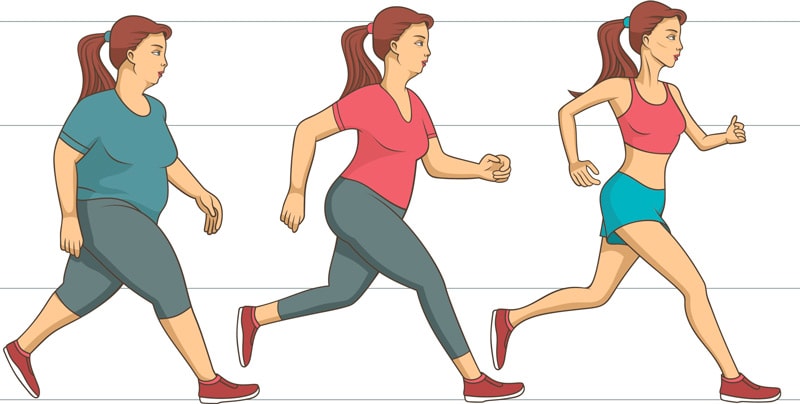How to run to lose weight
The first 40 minutes the body burns glycogen. Thus, the first 40-45 minutes of running will become a “warm-up” for those who want to lose weight, and fat will start to burn in the next 10-20 minutes. Run at a pace that is comfortable for you, not too fast or too slow. Perhaps jogging is for you.
Don’t forget recovery. You cannot make progress without rest, the muscles must recover. There must be at least one rest day per week. Don’t do more than two high-intensity workouts per week. Dedicate at least 50% of your workouts to long crosses (at least 60 minutes).
Run cross country for 50 to 90 minutes. Such a run requires sufficient physical fitness. It combines a steady cross at a low heart rate and uphill intervals with an increase in heart rate. This burns a lot of calories.

This technique will give a more tangible result, the weight lost can be 30-40% more than when running at the stadium. But not suitable for beginners.
Watch your breath, do not close your mouth while running, as you do while walking. Try to breathe through your mouth and nose at the same time: this way you can capture more oxygen with each breath, supplying it to muscles that will work longer without acidification.
Watch your pulse. Aerobic exercise will be effective only if the heart rate is within the target zone. To calculate, subtract your age from 220. The pulse during training should be no more than 80-90% of this value.
The pulse during a long cross-country race should never exceed 170 beats / min. If you see on your sports watch that the heart rate has already risen above 160, slow down.
Choose the right footwear. It is especially important for overweight runners to use shoes with enhanced cushioning. This is extremely important for the integrity of the joints. If you are obese, then don’t even try to run like professional track and field athletes on the forefoot. Land on your midfoot, and choose a park track and soft-surface stadium for training.
Running for weight loss: how and how much you need to run to lose weight
Contraindications to running for weight loss
Before you start running to lose weight, do not be too lazy to visit a general practitioner to find out if you have any contraindications. In overweight people, as a rule, contraindications are more common than in others.
It is forbidden to run for people with heart disease, hypertension, bronchial asthma, peptic ulcer. It is necessary to temporarily stop classes after abdominal surgical interventions. It is not recommended to run a lot for people with second or more degrees of varicose veins.
Heart rate zones: what heart rate to run on
Running heart rate is an important indicator of the effectiveness of a workout.
How do you know how effective you are training, is it too intense for a beginner, and how to improve your performance for an experienced athlete? Pay attention to the heart rate at which you conduct your workout. Each type of training is associated with a specific heart rate zone.
In the last decade, all kinds of gadgets with heart rate sensors have burst into the sports industry market. At the same time, a large number of studies in the field of physical culture and sports are devoted to training in the pulse zones.
What is heart rate and MHR
The heart rate indicator can be used to monitor heart health and fitness levels. There is a concept of heart rate – heart rate. This is a physiological indicator of the normal heart rate, which is widely used in sports practice. It is believed that the heart rate is the same as the pulse, but this is not entirely true. The pulse is the number of blood impulses that occur in the arteries over a certain period of time, the measured fluctuation of the walls of the vessels. Heart rate is the number of heartbeats in the same amount of time.

In a healthy adult at rest, the heart rate is equal to the pulse. The pulse is measured in beats per minute. Manually, the easiest way to measure is with a stopwatch, simply by placing a finger on the carotid artery. Heart rate depends on many factors and can vary significantly for various reasons. There are certain numerical limits, a significant departure from which is considered a pathology and can cause diseases of the cardiovascular system.
Like many indicators in our body, the pulse is a rather individual thing. For an unprepared athlete, even a quick step will raise the pulse to 130 beats / min, while for a trained runner at this moment the figure will not exceed 100 beats / min. Therefore, recently it has been customary to calculate pulse zones based not on heart rate numbers, but on a percentage of MHR (maximum heart rate).
MHR is the highest number of heartbeats per minute, which is achieved at the limit of the body’s capabilities during intense training. This is the highest number of beats per minute that your heart can make at maximum load.
The generalized formula for calculating MHR is 220 minus your age. A more modern formula is 214-(0.8 x age) for men and 209-(0.9 x age) for women. But it will be more informative to get the value in the laboratory.
